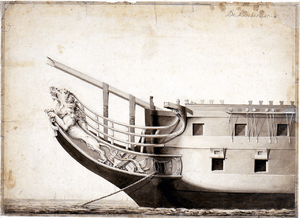Dutch ship Beschermer (1784)
Beschermer (Protector) was a Dutch 56-gun fourth-rate ship of the line of the Admiralty of the Noorderkwartier (one of five provincial navies of the United Provinces of the Netherlands). The order to construct the ship was given by the Admiralty of the Noorderkwartier.[1]
 Figurehead of the ship Beschermer. | |
| History | |
|---|---|
| Name: | Beschermer |
| Builder: | Enkhuizen |
| Laid down: | 1781 |
| Launched: | 1784 |
| Name: | Beschermer |
| Captured: | 30 August 1799 |
| Name: | HMS Beschermer |
| Acquired: | 1799 |
| Commissioned: | 1799 |
| Decommissioned: | 1806 |
| Out of service: | Lent to the East India Dock Company in 1806 |
| Reclassified: |
|
| Fate: | Sold, September 1838 |
| General characteristics | |
| Class and type: | 54-gun fourth-rate ship of the line |
| Tons burthen: | 1,051 67⁄94 (bm) |
| Length: | |
| Beam: | 40 ft 10 in (12.4 m) |
| Depth of hold: | 16 ft 4 in (5.0 m) |
| Sail plan: | Full rigged ship |
| Armament: |
|
In 1795 she became part of the Batavian Navy, following the French invasion of the Netherlands.
On 11 October 1797 Beschermer took part in the Battle of Camperdown under Captain Dooitze Eelkes Hinxt. The ship escaped the battle after Hinxt was severely wounded.[2]
On 30 August 1799 Beschermer, under Captain Eilbrach, was surrendered to the British during the Vlieter Incident. The Royal Navy then took her on in various subsidiary roles.
In 1801 Beschermer served as a guard ship in the Swin. She was fitted as a storeship in 1805. Beschermer was lent to the East India Dock Company for use as a hulk at Blackwall in 1806 until she was sold for breaking up in September 1838.[3][4]
Beschermer was eventually broken up in 1838.
Citations
- J.F. Fischer Fzn. De Delft: De dagjournalen met de complete en authentieke geschiedenis van 's Lands schip van oorlog Delft en de waarheid over de zeeslag bij Camperduin (Franeker: Van Wijnen, 1997), 135.
- J.F. Fischer Fzn. De Delft: De dagjournalen met de complete en authentieke geschiedenis van 's Lands schip van oorlog Delft en de waarheid over de zeeslag bij Camperduin (Franeker: Van Wijnen, 1997), 342.
- "BESCHERMER (54) [1799]". Ageofnelson.org. Retrieved 28 April 2016.
- Winfield (2008), p. 269.
References
- Winfield, Rif (2008). British Warships in the Age of Sail 1793–1817: Design, Construction, Careers and Fates. Seaforth Publishing. ISBN 1-86176-246-1.CS1 maint: ref=harv (link)